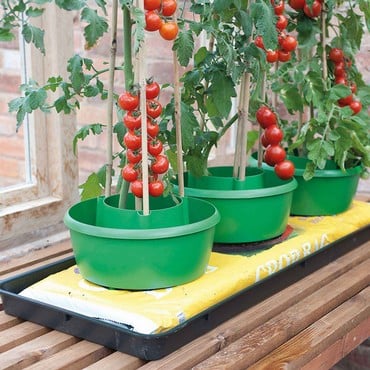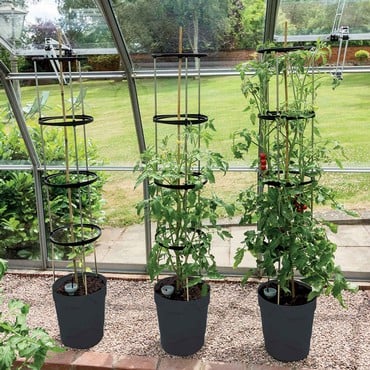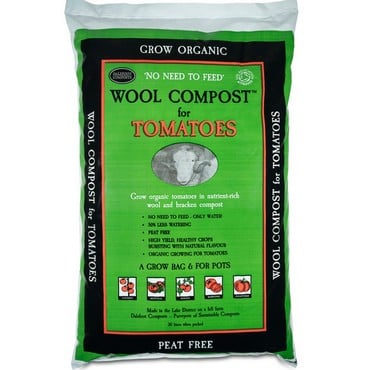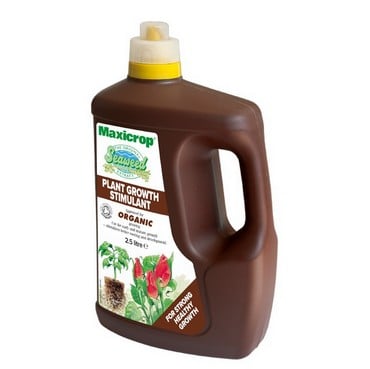You can’t beat the flavour of delicious home-grown tomatoes eaten straight from the vine. Once you taste tomatoes harvested fresh from your own patch, you’ll never again be satisfied with the supermarket imposters. Fortunately, tomatoes are easy to sow and grow too. Whether you’re looking for juicy, gigantic varieties, or a small, sweet cherry, there’s a fantastic array of shapes, colours, culinary uses and flavours to choose from.
Did you know? There are around 10,000 varieties of tomatoes worldwide.
The growing process
Pick your varieties
The vast choice of tomatoes available means you’re often spoilt for choice. We’ve sectioned the varieties by tomato type to help make your selections a little easier.
Cherry tomatoes
These tiny tomatoes are sweeter than other types and perfectly suitable for adding whole to salads, roasting or simply eating fresh from the plant.
Hundreds and thousands – This easy to grow variety really lives up to its name, producing literally thousands of sweet, juicy, bite-sized tomatoes throughout the whole summer.

Plum tomatoes
Oval shaped and fleshy, plum varieties are often used for tinned tomatoes. With fewer seeds, they are ideal for sauces, soups and sun drying.
San Marzano 2 – Classic, richly flavoured Italian plum tomato that is unsurpassed for sauces. Their combination of flavour, meaty texture and very small number of seeds makes then stand out from the crowd.
Standard tomatoes
Often thought of as being the most common type, these perfectly round tomatoes have bright red shiny skin, red pulp and white seeds.
Moneymaker – Popular for its uniformity and exceptional flavour, this well-known variety reliably produces plenty of smooth, medium-sized fruit throughout the summer.

Beefsteak tomatoes
These aptly named fruits are the big daddies of the tomato world. Their large size means they are great stacked on burgers, in BLTs, or as the star of the show in a caprese salad.
Gigantomo – As the name suggests, this ‘beefy’ tomato is an outstanding example of its type. The large fruits can weigh more than 1kg each and have an excellent texture and flavour.
Sowing
You can buy tomatoes as young plants, but if you’d like to try some of the more unique varieties it’s worth growing from seed. Start your tomatoes inside and move outside after the last frost in May. Choose a sunny, sheltered spot, where you can plant them into a border, or into 30cm pots. Alternatively, put two or three plants in a growing bag.
Can you grow tomatoes in a greenhouse? Most definitely. Growing tomatoes indoors produces an early crop, especially if you opt for varieties like Sungold or Money Maker. Sow in 7.5cm pots from February onwards, according to the instructions on your seed packet. Transplant seedlings when they reach about 2-3cm tall into 5cm pots filled with compost. Keep potting on as necessary. Tomatoes will perform poorly in temperatures above 27C, so make sure you the ventilate the greenhouse regularly to stop them overheating.
Tomato care advice
- Water in the early morning so that plants have sufficient moisture to make it through the day.
- Tomato branches can get very heavy so make sure they are supported.
- Remove any lower leaves from your tomato plants. These can easily develop fungus and other problems.
Feeding
Tomatoes are quite greedy feeders and need different nutrients during their life. Digging in a balanced fertiliser before planting is beneficial or a weekly feed with an organic liquid seaweed fertiliser will really help.
After the plants have set their first truss, then weekly feeding with a high postash/phosphorous fertiliser such as Tomorite. Keep feeding until the last tomatoes have started to ripen.
Harvesting
As soon as the fruit is ripe and fully coloured, regardless of size, it’s ready to pick and devour. Harvest tomatoes of other colours (orange, yellow, green) once they turn the correct colour.
Never store fresh garden tomatoes in the fridge. Doing so spoils the flavour and texture that give them that garden tomato taste. It’s also not a good idea to place tomatoes on a sunny windowsill, as they could rot before they ripen.
Tip: If a tomato hangs onto the vine for dear life when you try to pick it, it’s not yet ready. Ripe tomatoes should give way to a gentle tug.

Other uses for your surplus tomatoes
If you’re lucky, you’ll end with more tomatoes than you (and friends too) can eat in one season. Here’s some tasty ways to use up summer’s favourite fruit:
Gazpacho
This quintessential summer soup is bursting with fresh, delicious ingredients. It’s also incredibly simple to make: simply combine tomatoes, cucumber, bell peppers, bread (helps thicken), red onion, garlic, olive oil, sherry vinegar, ground cumin and sea salt and black pepper in a blender until the gazpacho reaches your desired consistency. Refrigerate for a few hours before serving.
Fresh and tangy salsa
Delicious and chunky tomato salsa is an excellent dip or accompaniment to Mexican inspired dishes. Consisting of finely chopped tomatoes, onion, garlic, chilli, parsley, plus some fresh lime juice, it’s quick and easy to prepare.
Tomato jam
Great on burgers in place of ketchup or served alongside grilled meat or fish. It also works as a delicious chutney with cheeses and cured meats. To make, combine granulated sugar with vinegar and water. Once reduced, add lots of ripe tomatoes and continue cooking until the ‘jam’ thickens. Store in the fridge and tuck into it with just about anything.
Homemade ketchup
Is there anything more delicious than tomato ketchup? Yes, the homemade kind. It’s simple to make, tastes better, and is far healthier for you than shop-bought varieties. Made using pureed fresh tomatoes, olive oil, an onion, brown sugar, vinegar, cinnamon powder, tomato paste and black pepper – it really couldn’t be easier.
Sun dried tomatoes
If you have a large glut of tomatoes to use up, slowly dehydrate them in a low oven for 6-8 hours, or until they become a deep red colour and are completely dry – not crispy. Transfer them to a jar, cover with oil and use in pasta dishes, salads, or as part of an antipasti spread.
































